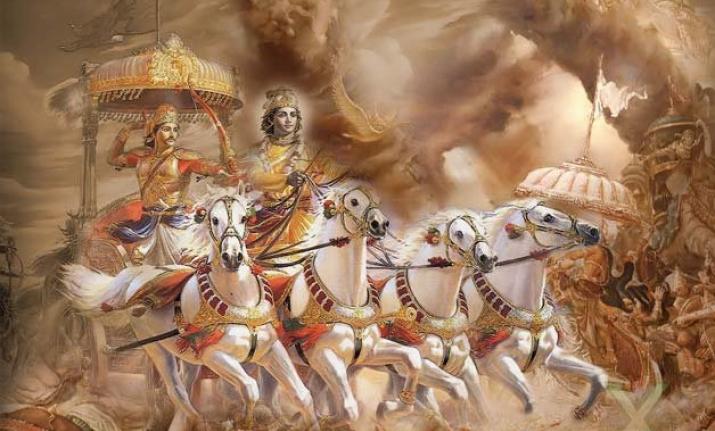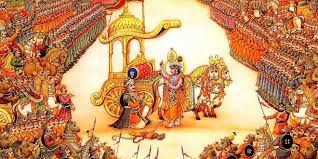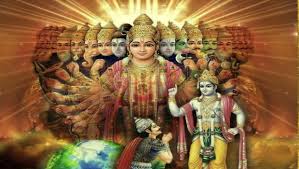श्रीमद् भगवद्गीता यथारूप 4.7
यदा यदा हि धर्मस्य ग्लानिर्भवति भारत ।
अभ्युत्थानमधर्मस्य तदात्मानं सृजाम्यहम् ॥ ४.७ ॥
Translation
हे भारतवंशी! जब भी और जहाँ भी धर्म का पतन होता है और अधर्म की प्रधानता होने लगती है, तब तब मैं अवतार लेता हूँ |
Purport
यहाँ पर सृजामि शब्द महत्त्वपूर्ण है | सृजामि सृष्टि के अर्थ में नहीं प्रयुक्त हो सकता, क्योंकि पिछले श्लोक के अनुसार भगवान् के स्वरूप या शरीर की सृष्टि नहीं होती, क्योंकि उनके सारे स्वरूप शाश्र्वत रूप से विद्यमान रहने वाले हैं | अतः सृजामि का अर्थ है कि भगवान् स्वयं यथारूप प्रकट होते हैं | यद्यपि भगवान् कार्यक्रमअनुसार अर्थात् ब्रह्मा के एक दिन में सातवें मनु के २८ वें युग में द्वापर के अन्त में प्रकट होते हैं, किन्तु वे इस समय का पालन करने के लिए बाध्य नहीं हैं, क्योंकि वे स्वेच्छा से कर्म करने के लिए स्वतन्त्र हैं | अतः जब भी अधर्म की प्रधानता तथा धर्म का लोप होने लगता है, तो वे स्वेच्छा से प्रकट होते हैं | धर्म के नियम वेदों में दिये हुए हैं और यदि इन नियमों के पालन में कोई तत्रुटि आती है तो मनुष्य अधार्मिक हो जाता है | श्रीमद्भागवत में बताया गया है कि ऐसे नियम भगवान् के नियम हैं | केवल भगवान् ही किसी धर्म की व्यवस्था कर सकते हैं | वेद भी मूलतः ब्रह्मा के हृदय में से भगवान् द्वारा उच्चारित माने जाते हैं | अतः धर्म के नियम भगवान् के प्रत्यक्ष आदेश हैं (धर्मं तु सा क्षा द् भगवत् प्रणीत म् ) | भगवद्गीता में आद्योपान्त इन्हीं नियमों का संकेत है | वेदों का उद्देश्य परमेश्र्वर के आदेशानुसार ऐसे नियमों की स्थापना करना है और गीता के अन्त में भगवान् स्वयं आदेश देते हैं कि सर्वोच्च धर्म उनकी ही शरण ग्रहण करना है |वैदिक नियम जीव को पूर्ण शरणागति की ओर अग्रसर कराने वाले हैं और जब भी असुरों द्वारा इन नियमों में व्यावधान आता है तभी भगवान् प्रकट होते हैं | श्रीमद्भागवत पुराण से हम जानते हैं की बुद्ध कृष्ण के अवतार हैं, जिनका प्रादुर्भाव उस समय हुआ जब भौतिकतावादी का बोलबाला था और भौतिकतावादी लोग वेदों को प्रमाण बनाकर उसकी आड़ ले रहे थे | भगवान् बुद्ध इस अनाचार को रोकने तथा अहिंसा के वैदिक नियमों की स्थापना करने के लिए अवतरित हुए | अतः भगवान् के प्रत्येक अवतार का विशेष उद्देश्य होता है और इन सबका वर्णन शास्त्रों में हुआ है | यह तथ्य नहीं है कि केवल भारत की धरती में भगवान् अवतरित होते हैं | वे कहीं भी और किसी भी काल में इच्छा होने पर प्रकट हो सकते हैं | वे प्रत्येक अवतार लेने पर धर्म के विषय में उतना ही कहते हैं, जितना कि उस परिस्थिति में जन-समुदाय विशेष समझ सकता है | लेकिन उद्देश्य एक ही रहता है – लोगों को ईश भावना भावित करना तथा धार्मिक नियमों के प्रति आज्ञाकारी बनाना | कभी वे स्वयं प्रकट होते हैं तो कभी अपने प्रामाणिक प्रतिनिधि को अपने पुत्र या दास के रूप में भेजते हैं, या वेश बदल कर स्वयं ही प्रकट होते हैं |
भगवद्गीता के सिद्धान्त अर्जुन से कहे गये थे,अतः वे किसी भी महापुरुष के प्रति हो सकते थेम क्योंकि अर्जुन संसार के अन्य भागों के सामान्य पुरुषों की अपेक्षा अधिक जागरूक था | दो और दो मिलाकर चार होते हैं, यह गणितीय नियम प्राथमिक कक्षा के विद्यार्थी के लिए उतना ही सत्य है, जितना कि उच्च कक्षा के विद्यार्थी के लिए | तो भी गणित उच्चस्तर तथा निम्नस्तर का होता है | अतः भगवान् प्रत्येक अवतार में एक-जैसे सिद्धान्तों की शिक्षा देते हैं, जो परिस्थितियों के अनुसार उच्च या निम्न प्रतीत होता हैं | जैसा कि आगे बताया जाएगा धर्म के उच्चतर सिद्धान्त चारों वर्णाश्रमों को स्वीकार करने से प्रारम्भ होते हैं | अवतारों का एकमात्र उद्देश्य सर्वत्र कृष्ण भावना मृत को उद्बोधित करना है | परिस्थिति के अनुसार यह भावनामृत प्रकट तथा अप्रकट होता है |
Bhagavad Gita As It Is 4.7
yadā yadā hi dharmasya
glānir bhavati bhārata
abhyutthānam adharmasya
tadātmānaṁ sṛjāmy aham
Translation
Whenever and wherever there is a decline in religious practice, O descendant of Bharata, and a predominant rise of irreligion – at that time I descend Myself.
Purport
The word sṛjāmi is significant herein. Sṛjāmi cannot be used in the sense of creation, because, according to the previous verse, there is no creation of the Lord’s form or body, since all of the forms are eternally existent. Therefore, sṛjāmi means that the Lord manifests Himself as He is. Although the Lord appears on schedule, namely at the end of the Dvāpara-yuga of the twenty-eighth millennium of the seventh Manu in one day of Brahmā, He has no obligation to adhere to such rules and regulations, because He is completely free to act in many ways at His will. He therefore appears by His own will whenever there is a predominance of irreligiosity and a disappearance of true religion. Principles of religion are laid down in the Vedas, and any discrepancy in the matter of properly executing the rules of the Vedas makes one irreligious. In the Bhāgavatam it is stated that such principles are the laws of the Lord. Only the Lord can manufacture a system of religion. The Vedas are also accepted as originally spoken by the Lord Himself to Brahmā, from within his heart.  Therefore, the principles of dharma, or religion, are the direct orders of the Supreme Personality of Godhead (dharmaṁ tu sākṣād bhagavat-praṇītam). These principles are clearly indicated throughout the Bhagavad-gītā. The purpose of the Vedas is to establish such principles under the order of the Supreme Lord, and the Lord directly orders, at the end of the Gītā, that the highest principle of religion is to surrender unto Him only, and nothing more. The Vedic principles push one towards complete surrender unto Him; and whenever such principles are disturbed by the demoniac, the Lord appears. From the Bhāgavatam we understand that Lord Buddha is the incarnation of Kṛṣṇa who appeared when materialism was rampant and materialists were using the pretext of the authority of the Vedas. Although there are certain restrictive rules and regulations regarding animal sacrifice for particular purposes in the Vedas, people of demonic tendency still took to animal sacrifice without reference to the Vedic principles. Lord Buddha appeared in order to stop this nonsense and to establish the Vedic principles of nonviolence.
Therefore, the principles of dharma, or religion, are the direct orders of the Supreme Personality of Godhead (dharmaṁ tu sākṣād bhagavat-praṇītam). These principles are clearly indicated throughout the Bhagavad-gītā. The purpose of the Vedas is to establish such principles under the order of the Supreme Lord, and the Lord directly orders, at the end of the Gītā, that the highest principle of religion is to surrender unto Him only, and nothing more. The Vedic principles push one towards complete surrender unto Him; and whenever such principles are disturbed by the demoniac, the Lord appears. From the Bhāgavatam we understand that Lord Buddha is the incarnation of Kṛṣṇa who appeared when materialism was rampant and materialists were using the pretext of the authority of the Vedas. Although there are certain restrictive rules and regulations regarding animal sacrifice for particular purposes in the Vedas, people of demonic tendency still took to animal sacrifice without reference to the Vedic principles. Lord Buddha appeared in order to stop this nonsense and to establish the Vedic principles of nonviolence.  Therefore each and every avatāra, or incarnation of the Lord, has a particular mission, and they are all described in the revealed scriptures. No one should be accepted as an avatāra unless he is referred to by scriptures. It is not a fact that the Lord appears only on Indian soil. He can manifest Himself anywhere and everywhere, and whenever He desires to appear. In each and every incarnation, He speaks as much about religion as can be understood by the particular people under their particular circumstances. But the mission is the same – to lead people to God consciousness and obedience to the principles of religion. Sometimes He descends personally, and sometimes He sends His bona fide representative in the form of His son, or servant, or Himself in some disguised form.
Therefore each and every avatāra, or incarnation of the Lord, has a particular mission, and they are all described in the revealed scriptures. No one should be accepted as an avatāra unless he is referred to by scriptures. It is not a fact that the Lord appears only on Indian soil. He can manifest Himself anywhere and everywhere, and whenever He desires to appear. In each and every incarnation, He speaks as much about religion as can be understood by the particular people under their particular circumstances. But the mission is the same – to lead people to God consciousness and obedience to the principles of religion. Sometimes He descends personally, and sometimes He sends His bona fide representative in the form of His son, or servant, or Himself in some disguised form.
The principles of the Bhagavad-gītā were spoken to Arjuna, and, for that matter, to other highly elevated persons, because he was highly advanced compared to ordinary persons in other parts of the world. Two plus two equals four is a mathematical principle that is true in the beginner’s arithmetic class and in the advanced class as well. Still, there are higher and lower mathematics. In all incarnations of the Lord, therefore, the same principles are taught, but they appear to be higher and lower in varied circumstances. The higher principles of religion begin with the acceptance of the four orders and the four statuses of social life, as will be explained later. The whole purpose of the mission of incarnations is to arouse Kṛṣṇa consciousness everywhere. Such consciousness is manifest and nonmanifest only under different circumstances.











